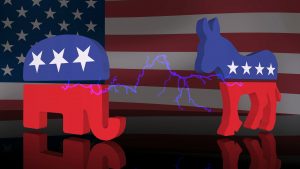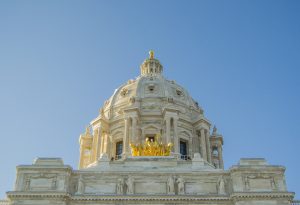Author: Jon Cieslak
Many guitarists and rock music fans have recently gotten to know Rick Beato. Beato is a musician, music producer, and, most recently, a YouTube personality. He regularly produces YouTube videos about a variety of music topics, headlined by his most well-known series, What Makes This Song Great?, which breaks down and discusses popular songs. He also occasionally discusses legal issues, particularly copyright law and fair use, as he has had videos removed from his YouTube channel.
In one video, Beato touches on antitrust law in his discussion of what he refers to as the Y2K curse. The Y2K curse refers to his observation that a large number of successful rock bands from the 1990s—Beato gives twenty eight examples, including Live, Cake, Counting Crows, Bush, Blur, Goo Goo Dolls, and Barenaked Ladies—“did nothing after the year 2000.” This is not because they stopped releasing albums; rather, their releases in the 2000s did not have the same commercial success. He admits that this was not a universal problem, as bands such as Foo Fighters, Green Day, Red Hot Chili Peppers, and Weezer were able to maintain their success.
So why did so many (but not all) rock bands suffer from the Y2K curse? Beato attributes much of it to a change in radio formats indirectly prompted by the Telecommunications Act of 1996. According to the FCC, the Act’s goal was “to let anyone enter any communications business—to let any communications business compete in any market against any other.” But what happened in practice was the drastic increase in the consolidation of media ownership, particularly in radio stations. As Beato explains, in 1983, 90% of American media was controlled by fifty companies. By 2011, 90% of American media was controlled by just six companies (GE, News-Corp, Disney, Viacom, Time Warner, and CBS). This consolidated media ownership resulted in “consolidated playlists” with far fewer “gatekeepers”—who are frequently now market researchers instead of DJs—deciding what music would be played on the radio. That smaller number of corporate gatekeepers, all concerned about offending the smallest number of potential listeners, resulted in less variety and eliminated the main outlet for many popular bands from the 1990s.
Assuming this is all true, would antitrust law provide a remedy for the loss of musical variety on the radio? After all, the goal of antitrust law is to prevent the ill effects of reduced competition.
Probably not. Antitrust law most likely would not provide a remedy because it generally does not recognize the loss of variety—without some associated detrimental effect on competition—as a cognizable anticompetitive harm.
This recalls an interesting debate among antitrust scholars about what “the primary concern of antitrust law” should be. Continental T.V., Inc. v. GTE Sylvania Inc., 433 U.S. 36, 51 n.19 (1977). The prevailing view—which the Supreme Court spurred with its Continental T.V. decision—is that federal antitrust laws should promote economic welfare (frequently referred to as consumer welfare) over other goals. As a leading antitrust treatise says, “economic concerns have generally dominated antitrust policy and trumped competing ‘populist’ concerns.” 1 PHILLIP E. AREEDA & HERBERT HOVENKAMP, ANTITRUST LAW ¶ 110 (5th ed. 2020). While the Supreme Court has never formally adopted the economic welfare standard—or any standard, for that matter—regulators, litigants, and courts frequently focus on price effects when evaluating alleged anticompetitive conduct. To be sure, those price effects should be based on quality-adjusted prices—i.e. prices that consider nonprice elements of a product that affect consumer preferences such as color, style, or brand reputation—but the economic welfare standard does not protect variety for variety’s sake.
Returning to Beato’s Y2K curse, application of the economic welfare standard would likely render antitrust law powerless to remedy the curse’s effects. The consolidation of media ownership and corresponding streamlining of radio playlists did not have the most common hallmarks of anticompetitive harm that courts usually consider. Prices for radio broadcasts did not go up. There was no substantial reduction in output of radio broadcasts. So unless a court was willing to find that the quality of radio broadcasts went down—while I would argue that Counting Crows are better than Limp Bizkit, I would not expect a court to take up the issue—it seems there was no loss of economic welfare and therefore no antitrust claim.
Not all antitrust scholars think this is the right result. Some have argued that the economic welfare standard is lacking precisely because it does a poor job of addressing nonprice competition. They have argued for a “consumer choice” standard instead of economic welfare, defined as business conduct “that harmfully and significantly limits the range of choices that the free market, absent the restraints being challenged, would have provided.” Neil W. Averitt & Robert H. Lande, Using the “Consumer Choice” Approach to Antitrust Law, 74 ANTITRUST L.J. 175, 184 (2007). If applied, the consumer choice standard would be more likely to provide a remedy for the Y2K curse.
Regulators and courts do sometimes consider diminished choices as indicative of anticompetitive activity. For example, in Associated Gen. Contractors v. Cal. State Council of Carpenters, 459 U.S. 519, 528 (1983), the Supreme Court held that “[c]oercive activity that prevents its victims from making free choices between market alternatives is inherently destructive of competitive conditions.” In Realcomp II, Ltd. v. FTC, 635 F.3d 815 (6th Cir. 2011), the Sixth Circuit upheld an FTC decision finding that certain policies violated the antitrust laws when they “narrow[ed] consumer choice” and “hinder[ed] the competitive process” without examining price effects.
 The Antitrust Attorney Blog
The Antitrust Attorney Blog












